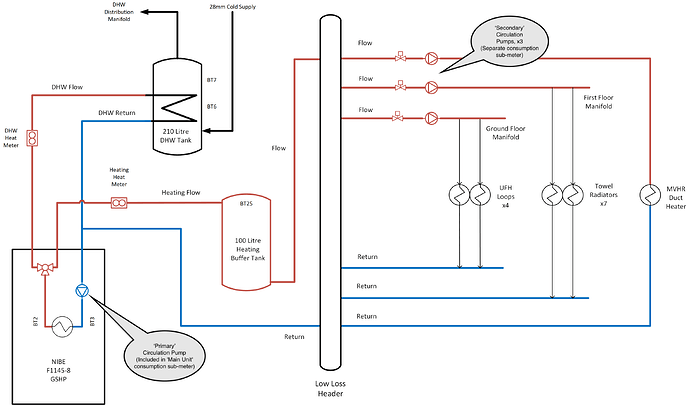Following last week’s EcoHome Lab webinar which some forum members attended (“In-situ heat pump performance in the UK” with Colin Meek) I’ve been thinking I should implement the changes to report my heat pump’s performance against the H4 System Boundary rather than H2 as I do currently.
I’ve got three circulation pumps with accompanying zone valves feeding different circuits on the emitter side of a Low-Loss Header which are powered separately from my main heat pump unit and so excluded from the sub-meter on the supply to the main unit. I’ve already added a second sub-meter measuring the electricity consumption of those pumps and valves which shows a total of 60W when they’re all ‘on’:
- The pumps are all the same (Grundfos ALPHA2L 15-50 130) so that’s 20W per pump & zone valve combination, which doesn’t seem bad
- The total of 60W is not insignificant though: 60W is 1.44 kWh per day, 43.2 kWh per month.
My plan is to amend the script I use to upload the readings to emoncms.org (for HeatpumpMonitor) so as to report the sum of the two electricity sub-meters:
- The one for my main (Ground Source) Heat Pump unit, which covers the compressor, the heat pump controller and the primary circulation pump (plus the ‘brine’ pump)
- The new one for the supplementary pumps and zone valves
So far so good; my question is whether it is legitimate to also include the second meter’s electricity consumption in the heat output figure (i.e. add it to the heat meter reading too).
The electricity consumed by each pump is partially going into the pumped fluid (and so appearing as heat via the emitters) and partially being dissipated via the pump’s housing. In both cases this is extra heating inside the house’s insulated envelope (albeit at CoP 1.0) but it’s ‘downstream’ of the heat meter so it’s not being recorded elsewhere.
I’ve reviewed the EST Heat Pump Field Trial paper from 2013 (PDF link) which contains a good summary of the SEPEMO-defined System Boundaries such as H2 and H4 but doesn’t appear to address my specific question.
I also found this DECC RHPP Detailed Analysis Report from the UCL Energy Institute in 2016 (PDF link) which has a specific Appendix B.4 addressing “Circulation pump power consumption” which includes the following:
…throughout this report it has been assumed that 100% of the electricity consumption of the pump is transferred as heat to the heating circuit…
My inclination is to add the supplementary consumption readings to the heat meter readings, since they do represent heat going into the house, but I don’t want to compromise the ability to compare my system with others.
For reference, my house is a nearly-Passivhaus and doesn’t need much heating. On average, during the heating season (October - March) the heat pump is using 190 kWh of electricity per month (as currently reported; H2 system boundary) and metering 705 kWh of heat output per month, so the SPF (H2) is 3.7, across CH and DHW.
The monthly 43 kWh from the supplementary pumps therefore represents 18.5% of the combined electricity consumption - which seems (to me at least) like a surprisingly large proportion, but only because the heating demand is relatively modest. From a quick calculation I reckon Including versus Excluding the heating effect of the pumps’ power consumption is worth about 0.2 of SPF.

